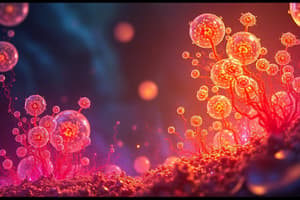Podcast
Questions and Answers
What happens to microbial growth rates as temperature increases beyond the optimum temperature?
What happens to microbial growth rates as temperature increases beyond the optimum temperature?
- Growth rates quickly decline. (correct)
- Growth rates remain constant.
- Growth rates continue to increase indefinitely.
- Enzyme activity stops completely.
Which type of microorganism thrives at temperatures below 10 degrees Celsius?
Which type of microorganism thrives at temperatures below 10 degrees Celsius?
- Thermophiles
- Mesophiles
- Psychrophiles (correct)
- Acidophiles
What is the optimum pH range for Neutrophiles?
What is the optimum pH range for Neutrophiles?
- pH between 6-8 (correct)
- pH between 4-5
- pH below 6
- pH above 8
Why do warmer temperatures increase the growth rate of microbes?
Why do warmer temperatures increase the growth rate of microbes?
What is the effect of maximum temperature on microbial growth?
What is the effect of maximum temperature on microbial growth?
Which type of microorganism has an optimum growth temperature above 40 degrees Celsius?
Which type of microorganism has an optimum growth temperature above 40 degrees Celsius?
Acidophiles are defined by their preference for what type of pH environment?
Acidophiles are defined by their preference for what type of pH environment?
What is the primary reason enzymes become denatured at high temperatures?
What is the primary reason enzymes become denatured at high temperatures?
Which of the following best describes mesophiles?
Which of the following best describes mesophiles?
What common characteristic is shared by Neutrophiles and Mesophiles?
What common characteristic is shared by Neutrophiles and Mesophiles?
What is the optimal pH range for alkalinophiles?
What is the optimal pH range for alkalinophiles?
Which description best fits acidotolerant organisms?
Which description best fits acidotolerant organisms?
What happens to a cell when it experiences crenation?
What happens to a cell when it experiences crenation?
In which type of environment do alkalinophiles thrive?
In which type of environment do alkalinophiles thrive?
Which factor primarily influences the movement of water across a plasma membrane?
Which factor primarily influences the movement of water across a plasma membrane?
What characteristic distinguishes acidotolerant organisms from alkalinophiles?
What characteristic distinguishes acidotolerant organisms from alkalinophiles?
What effect can an influx of water have on a cell without a cell wall?
What effect can an influx of water have on a cell without a cell wall?
What is the relationship between osmotic pressure and solute concentration?
What is the relationship between osmotic pressure and solute concentration?
What term describes organisms that grow optimally at neutral pH but can tolerate acidic conditions?
What term describes organisms that grow optimally at neutral pH but can tolerate acidic conditions?
Psychrophiles thrive in environments with temperatures above 10 degrees Celsius.
Psychrophiles thrive in environments with temperatures above 10 degrees Celsius.
Mesophiles are the majority of microbes and have an optimum temperature for growth between 20 to 40 degrees Celsius.
Mesophiles are the majority of microbes and have an optimum temperature for growth between 20 to 40 degrees Celsius.
Thermophiles can grow optimally at temperatures below 40 degrees Celsius.
Thermophiles can grow optimally at temperatures below 40 degrees Celsius.
Acidophiles prefer a pH range above 6 for optimal growth.
Acidophiles prefer a pH range above 6 for optimal growth.
All organisms have a defined optimum temperature, below which they cannot grow at all.
All organisms have a defined optimum temperature, below which they cannot grow at all.
Enzyme activity generally decreases as temperature increases, halting microbial growth.
Enzyme activity generally decreases as temperature increases, halting microbial growth.
Neutrophiles thrive in a neutral pH range between 6-8.
Neutrophiles thrive in a neutral pH range between 6-8.
Salt levels have no effect on microbial growth rates.
Salt levels have no effect on microbial growth rates.
The growth rate of microbes generally declines as temperature exceeds the maximum growth threshold.
The growth rate of microbes generally declines as temperature exceeds the maximum growth threshold.
Molecular movement decreases as temperature rises, hindering enzyme activity.
Molecular movement decreases as temperature rises, hindering enzyme activity.
Alkalinophiles thrive in a basic environment with a pH below 8.
Alkalinophiles thrive in a basic environment with a pH below 8.
Acidotolerant organisms prefer a neutral pH environment for optimal growth.
Acidotolerant organisms prefer a neutral pH environment for optimal growth.
There are many alkalinophiles found in nature.
There are many alkalinophiles found in nature.
Crenation occurs when water enters the cell, causing it to swell.
Crenation occurs when water enters the cell, causing it to swell.
The force of water that impacts a cell's plasma membrane is referred to as osmotic pressure.
The force of water that impacts a cell's plasma membrane is referred to as osmotic pressure.
Alkalinophiles and acidotolerant organisms are both classified as neutrophiles.
Alkalinophiles and acidotolerant organisms are both classified as neutrophiles.
Water moves across the plasma membrane through osmosis due to differences in solute distribution.
Water moves across the plasma membrane through osmosis due to differences in solute distribution.
Organisms that can grow in more acidic environments than most other microbes are called alkalinophiles.
Organisms that can grow in more acidic environments than most other microbes are called alkalinophiles.
When water enters a cell that lacks a cell wall, the cell can burst.
When water enters a cell that lacks a cell wall, the cell can burst.
The peak growth for acidotolerant organisms is in an acidic environment.
The peak growth for acidotolerant organisms is in an acidic environment.
What happens to a cell in a hypertonic solution?
What happens to a cell in a hypertonic solution?
Which of the following statements about halophiles is true?
Which of the following statements about halophiles is true?
Why are salt and sugar effective at inhibiting microbial growth?
Why are salt and sugar effective at inhibiting microbial growth?
What is a characteristic of most microbes that live in slightly hypotonic environments?
What is a characteristic of most microbes that live in slightly hypotonic environments?
Which best describes osmo files?
Which best describes osmo files?
What occurs when water moves into a cell that has a strong cell wall?
What occurs when water moves into a cell that has a strong cell wall?
What risk do hypertonic environments pose to most microbes?
What risk do hypertonic environments pose to most microbes?
Which of the following statements about osmo files and halophiles is accurate?
Which of the following statements about osmo files and halophiles is accurate?
Osmophiles are organisms that thrive in isotonic solutions.
Osmophiles are organisms that thrive in isotonic solutions.
Halophiles can survive in environments with high sugar concentrations.
Halophiles can survive in environments with high sugar concentrations.
Microbes living in slightly hypotonic environments absorb water to maintain cellular function.
Microbes living in slightly hypotonic environments absorb water to maintain cellular function.
Honey acts as a hypertonic solution that can inhibit microbial growth.
Honey acts as a hypertonic solution that can inhibit microbial growth.
All osmophiles are halophiles, but not all halophiles are osmophiles.
All osmophiles are halophiles, but not all halophiles are osmophiles.
Hypertonic solutions can cause microbial cells to swell and burst.
Hypertonic solutions can cause microbial cells to swell and burst.
The principle of salting food is based on creating an isotonic environment.
The principle of salting food is based on creating an isotonic environment.
Aerobes are microbes that can grow in the absence of oxygen.
Aerobes are microbes that can grow in the absence of oxygen.
Anaerobes possess enzymes to detoxify free radicals produced by oxygen.
Anaerobes possess enzymes to detoxify free radicals produced by oxygen.
Facultative anaerobes can grow with or without oxygen and have enzymes to handle free radicals.
Facultative anaerobes can grow with or without oxygen and have enzymes to handle free radicals.
Oxygen is toxic to all cells, but some can neutralize its harmful effects.
Oxygen is toxic to all cells, but some can neutralize its harmful effects.
Canisters with gas packs create an oxygen-rich environment for anaerobic microbial growth.
Canisters with gas packs create an oxygen-rich environment for anaerobic microbial growth.
Anaerobic hoods use a vacuum to replace oxygen with a gas mixture containing oxygen.
Anaerobic hoods use a vacuum to replace oxygen with a gas mixture containing oxygen.
Reducing media creates an oxygen gradient, with high levels at the bottom and diminishing levels towards the surface.
Reducing media creates an oxygen gradient, with high levels at the bottom and diminishing levels towards the surface.
Microbes that grow optimally in acidic environments are known as alkalinophiles.
Microbes that grow optimally in acidic environments are known as alkalinophiles.
What defines aerobes in terms of their growth condition?
What defines aerobes in terms of their growth condition?
Where do anaerobes grow within a reducing medium?
Where do anaerobes grow within a reducing medium?
What is a characteristic of facultative anaerobes?
What is a characteristic of facultative anaerobes?
What role do anaerobic canisters serve in microbiology?
What role do anaerobic canisters serve in microbiology?
What is a disadvantage of using an anaerobic hood?
What is a disadvantage of using an anaerobic hood?
What is the primary reason anaerobes do not grow in oxygenated environments?
What is the primary reason anaerobes do not grow in oxygenated environments?
Which type of microbe can thrive in both the presence and absence of oxygen?
Which type of microbe can thrive in both the presence and absence of oxygen?
Why do aerobes grow only at the surface of reducing medium?
Why do aerobes grow only at the surface of reducing medium?
What is the purpose of reducing medium in a laboratory setting?
What is the purpose of reducing medium in a laboratory setting?
How do enzymes in aerobes help them cope with oxygen?
How do enzymes in aerobes help them cope with oxygen?
Flashcards are hidden until you start studying
Study Notes
Temperature and Growth
- Microbial growth rate increases with temperature until an optimal temperature is reached.
- Beyond the optimal temperature, growth rate decreases rapidly.
- This pattern is due to the increased rate of enzymatic reactions at higher temperatures.
- However, excessively high temperatures can denature enzymes.
Microbial Temperature Classifications
- Psychrophiles: Optimal temperature under 10 degrees Celsius.
- Mesophiles: Optimal temperature between 20 to 40 degrees Celsius (majority of microbes, including human pathogens).
- Thermophiles: Optimal temperature above 40 degrees Celsius.
pH and Growth
- Microbial growth is also affected by pH, with an optimal pH for each species.
- Similar to temperature, growth is restricted above and below the optimal pH.
Microbial pH Classifications
- Neutrophiles: Optimal pH between 6-8 (majority of microbes).
- Acidophiles: Optimal pH below 6.
- Alkalinophiles: Optimal pH above 8.
Acidotolerance
- Some "acidotolerant" microbes, like Staphylococcus aureus, can grow in more acidic environments than most microbes.
- However, their optimal pH is still in a neutral range.
Osmotic Pressure and Growth
- Osmotic pressure is the force water exerts on the cell membrane.
- Water moves across the membrane due to differences in solute concentration between the environment and the cell.
- This can lead to crenation (cell shrinkage) or swelling/bursting (if no cell wall) depending on the direction of water movement.
Temperature and Growth
- Temperature significantly affects microbial growth rates, with warmer temperatures generally accelerating growth and cooler temperatures slowing it down.
- Every organism has a minimum temperature for growth, below which no growth occurs, and a maximum temperature, above which no growth occurs.
- There is an optimum temperature for growth, where the growth rate is fastest.
- Warmer temperatures increase growth rate because heat corresponds to increased molecular movement, making it more likely for enzymes to encounter their substrates and complete reactions.
- However, excessively high temperatures can denature enzymes, disrupting their function.
- Microbes are classified based on their optimum growth temperatures:
- Psychrophiles: Optimum growth below 10°C.
- Mesophiles: Optimum growth between 20-40°C. Most microbes, including human pathogens, are mesophiles.
- Thermophiles: Optimum growth above 40°C.
pH and Growth
- pH also significantly impacts microbial growth.
- Similar to temperature, each organism possesses a minimum pH, a maximum pH, and an optimum pH for growth.
- Microbes are classified based on their optimum pH:
- Neutrophiles: Optimum growth between pH 6-8. This group encompasses the majority of microbes.
- Acidophiles: Optimum growth below pH 6, within acidic environments.
- Alkalinophiles: Optimum growth above pH 8, within basic environments. These are relatively rare.
- Acidotolerant organisms are a type of neutrophile that grows fastest in neutral environments but can tolerate more acidic conditions than most microbes.
- They possess a broader pH tolerance range but maintain a neutral optimum.
Osmotic Pressure and Growth
- Osmotic pressure is the force exerted by water on the semi-permeable plasma membrane surrounding the cell.
- Water moves across the plasma membrane through osmosis when the concentration of solutes differs between the environment and the cell's interior.
- This osmotic movement can lead to:
- Crenation: Cell shrinkage when water exits the cell due to higher solute concentration outside.
- Swelling or bursting: Cell swelling or bursting (if there is no cell wall) when water enters the cell due to higher solute concentration inside.
Osmotic Pressure and Microbial Growth
- Isotonic, Hypotonic, and Hypertonic Solutions: These terms describe the relative solute concentration of a cell's internal environment compared to its external environment.
- Isotonic Solutions: The cell's internal and external solute concentrations are equal, resulting in balanced water movement across the cell membrane.
- Hypotonic Solutions: The solute concentration outside the cell is lower than inside, causing water to move into the cell to dilute the cytoplasm. Most microbes thrive in slightly hypotonic environments.
- Hypertonic Solutions: The solute concentration outside the cell is higher than inside, causing water to leave the cell. This can lead to cell shrinkage and death.
- Salt and Sugar as Hypertonic Agents: These substances create hypertonic solutions, drawing water out of microbial cells and inhibiting growth. This is the principle behind preserving food using salting or drying.
- Osmophiles: Microorganisms that can survive and thrive in high osmotic pressure environments (hypertonic solutions).
- Halophiles: A specific type of osmophile that can tolerate high salt concentrations. All halophiles are osmophiles, but not all osmophiles are halophiles.
- Honey as an Example of a Hypertonic Solution: It contains high sugar concentrations, making it a hypertonic environment. Microbes that can grow in honey are osmophiles but not halophiles.
Oxygen Requirements in Microbial Growth
- Reducing Medium is a liquid broth used to grow microbes with varying oxygen needs. It absorbs oxygen, creating an oxygen gradient where oxygen levels are high on the surface and low deeper in the medium.
- Aerobes require oxygen for metabolism and grow only at the surface of reducing media, where oxygen levels are highest.
- Anaerobes cannot tolerate oxygen and grow only in the absence of oxygen, found at the bottom of reducing media where oxygen levels are lowest. This is because they lack enzymes to detoxify free radicals produced by oxygen, making it toxic.
- Facultative Anaerobes can thrive in both oxygen-rich and oxygen-poor environments. They possess enzymes that allow them to survive in the presence of oxygen by neutralizing free radicals.
- Oxygen Toxicity is a challenge for all cells due to the production of free radicals during metabolic processes. However, organisms that grow in oxygenated environments have developed enzymes to combat these harmful molecules.
- Anaerobic Culture Techniques are essential for growing and studying anaerobic microbes:
- Canisters with Gas Packs create a controlled anaerobic environment within a sealed canister. A gas pack removes oxygen from the air, allowing anaerobic microbes to grow.
- Anaerobic Hoods provide a controlled environment for culturing and manipulating anaerobic microbes. They are sealed chambers where vacuum technology removes oxygen and replaces it with a gas mixture without oxygen.
Oxygen and Microbial Growth
- Oxygen concentration decreases with depth in liquid broth.
- Different types of microbes require different oxygen levels for growth.
Types of Microbes Based on Oxygen Requirements
- Aerobes require oxygen for metabolism and grow only at the surface of a reducing medium where oxygen is present.
- Aerobes possess enzymes to eliminate oxygen free radicals.
- Anaerobes cannot grow in the presence of oxygen and grow at the bottom of reducing media where there is no oxygen.
- Anaerobes lack enzymes to eliminate oxygen free radicals.
- Facultative Anaerobes can grow with or without oxygen.
- Facultative Anaerobes grow throughout the reducing medium, possessing enzymes to eliminate free radicals when growing in oxygenated environments.
Tools and Methods for Anaerobic Culture
- Reducing media are used to determine oxygen requirements for microbes in a laboratory setting.
- Anaerobic canisters are used for culturing anaerobic organisms in clinics.
- Anaerobic canisters create an oxygen-free environment using a gas pack that removes oxygen from the air.
- Anaerobic canisters are important for diagnosing anaerobic infections.
- Anaerobic Hoods are used in hospital laboratories and research facilities to cultivate large quantities of anaerobic microbes.
- Anaerobic Hoods are vacuum-sealed chambers that remove oxygen and replace it with a gas mixture that lacks oxygen.
- Anaerobic Hoods are challenging to work with due to limited access.
Studying That Suits You
Use AI to generate personalized quizzes and flashcards to suit your learning preferences.




